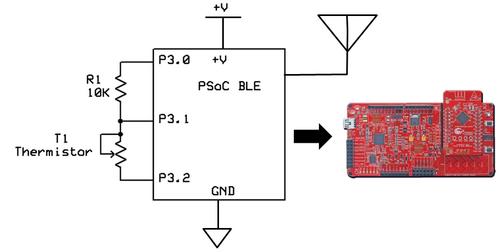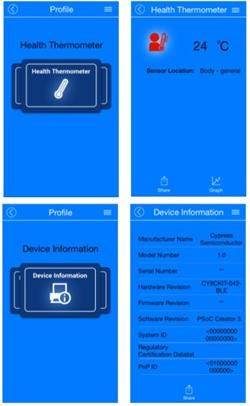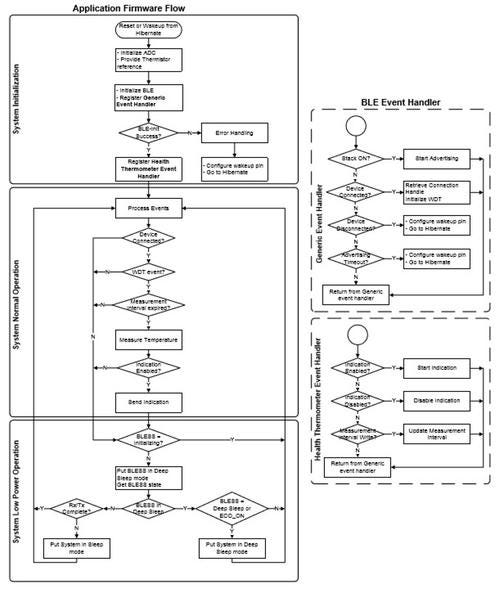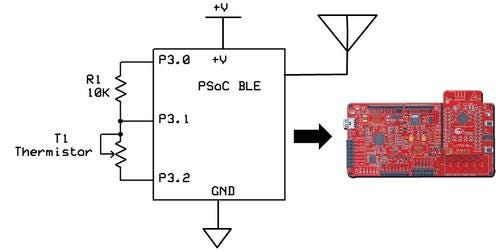April 15, 2015

The business and educational opportunities of Internet of Things (IoT) are abundant. Cisco's forecast of every device being connected by 2025 -- the Internet of Everything -- is achievable by applying today's embedded development tools to wireless innovations of tomorrow. As a high school and college educator, I'm constantly looking at emerging tech trends and training tools that prepare my students for future employment opportunities.
As an example, I continue to explore ways to teach embedded development in the world of IoT technologies through cool lab projects and curricula for my CTE (Career Technical Education) high school students, most recently using Cypress Semiconductor's Bluetooth Low Energy (BLE) electronic health thermometer application from the company's BLE Pioneer Kit. It is one that my students can investigate hands-on at the lab bench.
Education Based on New Product Development
I'm using the BLE Pioneer Kit, with its PSoC board and the health thermometer software, as a new product development training tool to show IoT concepts to my CTE electronics technology students. The health thermometer is a BLE device that transmits temperature data to a smartphone (iOS and Android devices). In addition to using a BLE board, a few electronic parts are required for the IoT project.
MORE FROM DESIGN NEWS: A Peek Into Cypress' BLE Pioneer Kit for IoT
The main learning objective behind this IoT proof-of-concept (PoC) project is to illustrate how a wireless sensor can be built to send environmental data to a mobile device using BLE technology. Also, this project illustrates to my students the engineering process of developing embedded products.
The basic engineering steps to new product development creation that I teach my students are:
Receive customer product requirements
Develop product specifications (hardware/software)
Build PoC prototype
Test PoC prototype
Demo PoC prototype to customer
Revise PoC prototype for manufacturing production
Product launch
I take a hands-on approach of explaining the new product development creation process by allowing the students to write the requirements, product specifications, and build the PoC prototypes. The product-requirements discussion focuses on understanding the customer needs for the intended electronic device.
The product requirements for our BLE electronic thermometer consist of a remote sensor transmitting temperature data to a smartphone. The smartphone is to provide an easy user interface (UI) for the customer to obtain temperature data from the remote sensor as well device information on the BLE device. The UI will display temperature updates from a remote sensor in the field.

A Product Specifications Development Exercise
With an understanding of the customer product requirements, my CTE students will be introduced to developing hardware and software product specifications for the health thermometer. Cypress' PSoC 4 board is a development platform of choice because of its ease in building electronic devices using the PSoC Creator software. Also, all of the generated files (.c , .h, and hex) are included along with the product description document in a conveniently zipped file.
The PSoC Creator software is the perfect tool to generate products specifications because of the hierarchical diagram and the previous documentation and files mentioned. The PSoC board is an excellent training tool for introducing high school STEM and CTE students to the world of embedded technologies because of the low learning curve. The goal is to show my students how the health thermometer's hierarchical diagram can be used as a hardware-requirements tool to obtain new features and functions for the electronic temperature product.

In addition, the health thermometer's flowchart that's part of the product description document can be used to explain embedded software requirements to my students, as well. BLE event handler flowchart routines used in the PSoC software provide an excellent instructional tool to discuss programming concepts such as logic design, firmware, and function prototypes used in developing embedded products.

Build a Proof-of-Concept Prototype
The ease of adding electronic components to the BLE Pioneer Kit allows my students to explore features and functions physically. The kit has a series of female headers like an Arduino for wiring additional electronic components and circuits. To make the kit work as a remote sensor, a temperature monitoring circuit is wired to the PSoC board's port pins P3.0, P3.1, and P3.2.

After the health thermometer software is programmed into the board, the embedded radio transmits temperature data immediately. The learning objectives behind this phase of the curriculum development project are to teach the following electrical engineering skills:
Reading and interpreting circuit schematic diagrams
Breadboarding circuits
Electronic components identification (thru-hole-leaded) and SMD (surface- mount devices) parts)
Printed circuit board construction
Electronic circuit interfacing
These basic skills are critical for the new generation of electrical engineers because to set up assembly processes and correct build problems in the manufacturing phase, knowledge and hands-on experience will help at this latter, critical stage of new product development.
In my next article, I'll explain the remaining engineering steps, and my inclusion of IoT concepts and Bluetooth Smart technology to the curriculum for my high school electronics students.
Don Wilcher is a passionate teacher of electronics technology and an electrical engineer with 26 years of industrial experience. He's worked on industrial robotics systems, automotive electronic modules/systems, and embedded wireless controls for small consumer appliances. He's also a book author, writing DIY project books on electronics and robotics technologies. His latest book, Make: Basic Arduino Projects, published by Maker Media, is on the Alabama State Department's approved Career and Technical Education (CTE) reading list. He's currently developing 21st century educational training products and curriculum focusing on Internet of Things (IoT) and Industrial Physical Computing for makers, engineers, technicians, and educators. Besides being an Electrical Engineer, he's a Certified Electronics Technician with ETA International and Alabama State Certified Electronics Instructor.
Design engineers, New England's premier design and manufacturing event, Design & Manufacturing New England, will take place in Boston, May 6-7, 2015. A Design News event, Design & Manufacturing New England is your chance to meet qualified suppliers, get hands-on with the latest technologies, be informed, and expand your network. Learn more here.
About the Author(s)
You May Also Like





